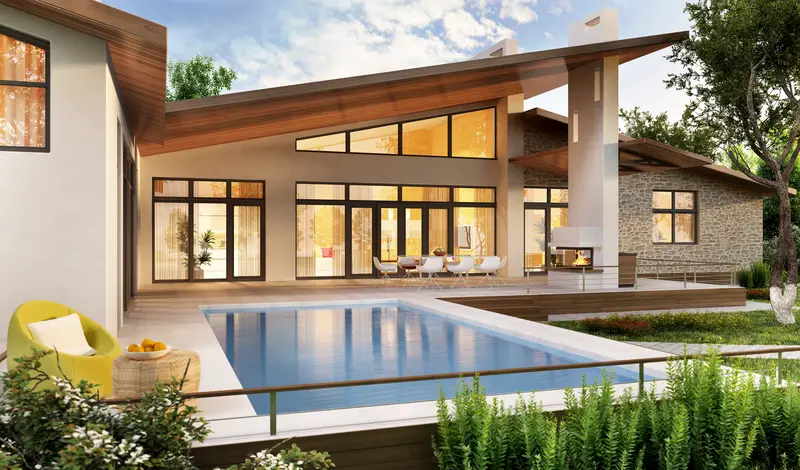Thinking about selling your home? You might be in for a surprise. Did you know that some features you think make your house special could actually turn off potential buyers? A busy street that never bothered you might be a deal-breaker for someone else. Or that swimming pool you loved might be seen as nothing but a money pit to maintain. Before you list your home, it’s worth knowing which features might make buyers walk away—or worse, not even schedule a viewing in the first place.
Living next to a school creates daily headaches
While many parents dream of living close to good schools, having a school right next door comes with major downsides that can make your home tough to sell. The morning and afternoon traffic jams as parents drop off and pick up their kids can trap you in your own driveway. And then there’s the noise—school bells, kids yelling during recess, and sports events on weekends. Weekday evenings might bring school concerts, PTA meetings, or other events with cars parked all along your street.
For potential buyers without kids, these problems might make them cross your home off their list immediately. Even for families with school-aged children, the lack of privacy and constant noise can outweigh the convenience of proximity. Studies show that homes directly next to schools can take significantly longer to sell and often go for 5-10% less than similar homes just a few blocks away. If you’re stuck with this situation, you might need to price your home more competitively or highlight other benefits to offset this location drawback.
Your home sits on a busy street with constant traffic
That convenient main road location that gets you home quickly might be the very thing keeping your house from selling. Homes on busy streets face serious safety concerns, especially for families with small children or pets. The constant noise from passing cars, trucks, and buses can make relaxing on your front porch impossible and even penetrate inside your home. And trying to back out of your driveway during rush hour? That daily struggle can be enough to send potential buyers looking elsewhere.
The statistics back this up—homes on busy streets typically sell for 5-10% less than similar homes on quiet streets. Some buyers won’t even consider them, no matter how nice the house itself might be. If your home faces this challenge, consider improvements that might help, like better sound insulation, privacy fencing, or landscaping that creates a buffer zone. These additions won’t completely solve the problem, but they might help some buyers see past the location issue. You might also target marketing toward buyers who prioritize shorter commutes over peaceful surroundings.
Power lines or cell towers visible from your property
Those giant metal structures looming over your backyard are more than just an eyesore—they’re often a major turnoff for potential buyers. Even though research hasn’t conclusively proven health risks from living near power lines or cell towers, the perception alone is enough to scare off many house hunters. The visual impact can be dramatic, making an otherwise lovely view seem industrial and unappealing. This aesthetic problem alone can significantly reduce your home’s curb appeal and make first impressions disappointing.
Real estate data shows that homes near power lines can sell for up to 10% less than comparable properties without this issue. Cell towers might have a slightly smaller impact, but still affect desirability. If your home has this challenge, strategic landscaping might help minimize the visual impact. Tall trees or privacy screens can sometimes help create a more appealing backdrop. When listing, you might focus on interior photos that showcase your home’s strengths and downplay the exterior views. Being upfront about pricing can also help attract buyers who might otherwise pass on viewing your property.
Swimming pools cost more money than they’re worth
That sparkling backyard pool that gave you years of summer fun might actually be shrinking your buyer pool. While pools are desirable in some markets, they’re often seen as expensive headaches in many others. Potential buyers mentally add up the costs: regular maintenance, chemicals, higher insurance rates, safety concerns, and repairs when equipment breaks down. Even in warm climates, many buyers balk at the thought of spending thousands each year just to maintain a feature they might only use occasionally.
Families with very young children often avoid homes with pools due to safety worries, instantly eliminating a large segment of potential buyers. Others may see the space a pool takes up as wasted yard area that could be better used for gardening, play equipment, or entertaining. If your home has a pool, consider getting a pre-inspection to prove it’s in good working order. You might also want to look into temporary safety covers that can be easily removed if the new owners want to use the pool. This helps address safety concerns while showing the pool can be safely covered when not in use.
Unique customized rooms limit buyer imagination
That room you converted into a home theater complete with built-in seating and sound-proofing might have been perfect for your family movie nights. But to potential buyers, it might look like an expensive renovation project they’ll need to tackle before moving in. Highly specialized rooms—like dedicated home theaters, wine cellars, or custom built-in aquariums—often appeal to a very small segment of the buying population. Most house hunters want flexible spaces they can adapt to their own needs and lifestyles.
Other examples of overly personalized spaces that can limit buyer interest include converted garages, elaborate home gyms with built-in equipment, indoor basketball courts, or rooms designed around specific hobbies. If possible, consider converting these spaces back to more neutral uses before listing your home. If that’s not practical, staging these areas to show alternative possibilities can help buyers see past your custom features. Having a floor plan that shows how the space could be reconfigured might also help overcome this obstacle. Remember that buyers often struggle to see past what’s right in front of them.
Outdated features signal expensive renovations ahead
Those popcorn ceilings and wood paneling might seem retro-cool to you, but to most buyers, they scream “expensive update needed.” Today’s buyers often want move-in ready homes, not renovation projects. Features like popcorn ceilings, shag carpeting, wood paneling, and outdated bathroom fixtures can make your entire home feel stuck in the past. Kitchens with laminate countertops, outdated appliances, or worn cabinets are particularly problematic since kitchen renovations are among the most expensive updates.
Consider tackling the most visible outdated features before listing. New kitchen faucets and cabinet hardware offer big visual improvements for relatively little money. Fresh paint in neutral colors can instantly modernize wood paneling or dated walls. For popcorn ceilings, professional removal is often worth the investment. If you can’t afford major updates, get estimates for the most obvious renovation needs and be prepared to adjust your asking price accordingly. Many buyers will mentally subtract the cost of renovations (plus extra for hassle) from what they’re willing to offer.
A single bathroom makes modern life difficult
Older homes with just one bathroom face serious challenges in today’s real estate market. Modern families expect multiple bathrooms—at minimum, a master bathroom plus another full bath for kids or guests. The thought of a morning line for the shower or having guests use the family’s only bathroom can be enough to send buyers looking elsewhere. This limitation can be particularly problematic in homes with three or more bedrooms, as the bathroom-to-bedroom ratio feels especially inadequate.
If your single-bathroom home has been on the market for months without serious interest, you might need to consider adding another bathroom before relisting. While this represents a significant investment, the return is usually worth it. Even a small half bath added under a staircase or carved from a closet can make your home much more marketable. If adding a bathroom isn’t feasible, significant price adjustments may be necessary. Be prepared for buyers to request allowances for bathroom additions in their offers, effectively reducing your net proceeds from the sale.
Multiple foreclosures nearby drag down everyone’s value
Even if your home is in perfect condition, the houses around you can make it nearly impossible to sell at a fair price. Multiple foreclosures in your neighborhood send up red flags for potential buyers and their lenders. They signal potential neighborhood decline and can dramatically reduce your property value through no fault of your own. Research shows that each foreclosed property within 500 feet of your home can reduce your property value by approximately 1-2%, with multiple foreclosures having a compounding effect.
Beyond the statistical impact on value, foreclosures often lead to vacant properties that may not be properly maintained. Overgrown lawns, peeling paint, and general disrepair can make the entire street look less desirable. If your neighborhood is experiencing a wave of foreclosures, you might need to postpone selling if possible. If waiting isn’t an option, consider working with neighbors to maintain the appearance of vacant properties, even if that means mowing a neighbor’s lawn or picking up their newspapers. These small efforts can help maintain the overall appearance of the neighborhood during showings.
Before you list your home, take an honest look at these potential problems. Some issues, like outdated features, can be fixed with strategic updates. Others, like location problems, require pricing adjustments or creative marketing. Understanding these challenges in advance can help you set realistic expectations and develop a smart selling strategy. Remember that even homes with challenging features do eventually sell—it just might take the right buyer, the right price, or both. Working with an experienced real estate agent who knows how to overcome these obstacles can make all the difference.

